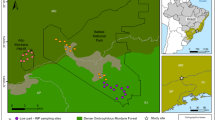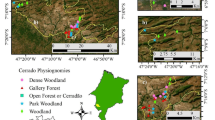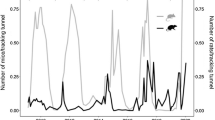Abstract
We compared the relative contribution of blackwater inundation forest (igapó) and unflooded (terra firme) forest for regional bird species diversity in the lower Rio Negro region. For analyses of habitat preference we used mist-net samples and an unpublished bird species check-list. The igapó forest had lower bird species diversity than the terra firme forest. However, some 14% of the forest bird species in the region are restricted to igapó forest. Species composition was found to be distinct between the understories of the two forest types. Common forest bird guilds in the Neotropics such as ant-following birds avoid igapó forest. The differential habitat selection among birds in the inundated and unflooded forest is likely to result from vegetation structure and biological interactions such as aggressive behaviour. Since the inundated forest has a typical biota, conservation efforts needs to be directed to protect these habitats. Unfortunately, inundation forests are threatened by several human actions, especially dam construction. The extent of protected areas in the Brazilian Amazon is insufficient for the adequate protection of the inundated habitats, because it includes only 3% of the total area.
Similar content being viewed by others
References
Adis J (1997) Terrestrial invertebrates: survival strategies, group spectrum, dominance and activity patterns. In: Junk WJ (ed) The Central Amazon Floodplain, Ecology of a Pulsing System, pp 299–314. Springer-Verlag, Berlin/Heidelberg
Bodmer RE (1990) Responses of ungulates to seasonal inundation in the Amazon floodplain. Journal of Tropical Ecology 6: 191–201
Conservation International (1991) Biological priorities for conservation in Amazonia. Map developed during the Workshop 90, Manaus, Brazil
Constantino R (1992) Abundance and diversity of termites (Insecta: Isoptera) in two sites of primary rain forest in Brazilian Amazonia. Biotropica 24: 420–430
D’Oliveira MVN (1989) Regeneração natural de uma floresta de várzea explorada por método tradicional, no Paraná Abufari no médio rio PurÚs. Unpublished master’s thesis, INPA, 75 pp
Erwin TL and Adis J (1982) Amazonian inundation forests - their role as short-term refuges and generators of species richness and taxon pulses. In: Biological Diversification in the Tropics, pp 358–371. Proceedings of 5th International Symposium on Association of Tropical Biology, Macuto Beach, Caracas, Venezuela
Fearnside P and Ferraz J (1995) A conservation gap analysis of Brazil’s amazonian vegetation. Conservation Biology 9: 1134–1147
Fearnside P (1995) Hydroelectric dams in the brazilian Amazon as sources of ‘greenhouse’ gases. Environmental Conservation 22: 7–19
Ferreira LV (1997) Effects of the duration of flooding on species richness and floristic composition in three hectares in JaÚ National Park in floodplain forest in Central Amazonia. Biodiversity and Conservation 6: 1353–1363
Fundação Vitória Amazônica (1988) Plano de manejo do Parque Nacional do JaÚ. FVA/IBAMA, Manaus, 258 pp
Gascon C (1996) Amphibian litter fauna and river barriers in flooded and non-flooded amazonian rain forests. Biotropica 28: 136–140
Hilty SL and Brown WL (1986) A Guide to the Birds of Colombia. Princeton University Press, Princeton, New Jersey
Irion G, Junk WJ and Nunes de JAS (1997) The large Central Amazonian river floodplains near Manaus: geological, climatological, hydrological and geomorphological aspects. In: Junk WJ (ed) The Central Amazon Floodplain, Ecology of a Pulsing System, pp 23–46. Springer-Verlag, Berlin/Heidelberg
Junk WJ and Mello JAS N (1987) Impactos ecológicos das represas hidrelétricas na bacia amazônica brasileira. Tübinger Beiträge zur Geographischen Lateinamerika-Forschung, 95: 367–385
Junk WJ (1989) Flood tolerance and tree distribution in Central Amazonian floodplains. In: Holm-Nielsen LB, Nielsen IC and Balslev H (eds) Tropical Forests: Dynamics, Speciation and Diversity, pp 47–64. Academic Press, London
Keel SHK and Prance GT (1979) Studies on the vegetation of a white-sand, black water igapó Rio Negro, Brazil. Acta Amazonica 9: 645–655
Klinge H and Furch K (1991) Towards the classification of Amazonian floodplains and their forests by means of biogeochemical criteria of river water and forest biomass. Interciencia 16: 196–201
Lovejoy TE (1975) Bird diversity and abundance in amazon forest communities. Living Bird 13: 127–188
Magurran AE (1988) Ecological diversity and its measurements. Princeton University Press, Princeton, New Jersey
Novaes FC (1958) As aves e as comunidades bióticas no alto rio Juruá, território do Acre. Boletim do Museu Paraense Emílio Goeldi (nova série) 14: 1–13
Novaes FC (1970) Distribuição ecológica e abundância das aves de um trecho da mata do baixo rio Guamá (estado do Pará). Boletim do Museu Paraense Emílio Goeldi (nova série) 71: 1–54
Novaes FC (1994) Aves da floresta de igapó, rio Negro (Estado do Amazonas), Brasil. Boletim do Museu Paraense Emílio (série Zoologia) 10: 155–167
Oren DC and Albuquerque HG (1991) Priority areas for new collections in Brazilian Amazonia. Goeldiana (zoologia) 6: 1–11
Peres CA (1997) Primate community structure at twenty western Amazonian flooded and unflooded forests. Journal of Tropical Ecology 13: 381–406
Petermann P (1997) The birds. In: Junk WJ (ed) The Central Amazon Floodplain, Ecology of a Pulsing System, pp 299–314. Springer-Verlag, Berlin/Heidelberg
Pires JM and Prance GT (1985) The vegetation types of brazilian Amazon. In: Prance GT and Lovejoy TE (eds) Amazonia, pp 109–145. Pergamon Press, New York
Remsen JV and Parker TA (1983) Contribution of river-created habitats to bird species richness in Amazonia. Biotropica 15: 223–231
Robinson SK and Terborgh J (1995) Interspecific aggression and habitat selection by Amazonian birds. Journal of Animal Ecology 64: 1–11
Rosenberg GH (1990) Habitat specialization and foraging behaviour by birds of Amazonian river island in Northeastern Peru. Condor 92: 427–443
Rylands AB (1991) The Status of Conservation Areas in the Brazilian Amazon. World Wildlife Fund & The Conservation Foundation, 146 pp
Silva JMC da, Constantino R (1988) Aves de um trecho de mata no baixo rio Guamá - uma reanálise: riqueza, raridade, diversidade, similaridade e preferências ecológicas. Bol. Mus. Para. Emílio Goeldi, sér. Zool. 4: 201–210
Terborgh J (1985) Habitat selection in Amazonian birds. In: Cody ML (ed) Habitat Selection in Birds, pp 311–335. Academic Press, New York
Veríssimo A, Barreto P, Matos M, Tarifa R, Uhl C (1995) Impactos da atividade madereira e perspectivas para o manejo sustentável da floresta numa velha fronteira da Amazônia: o caso de Paragominas. IMAZON, Belém, 27 pp
Worbes M (1997) The forest ecosystem of the floodplains. In: Junk WJ (ed) The Central Amazon Floodplain, Ecology of a Pulsing System, pp 222–264. Springer-Verlag, Berlin/Heidelberg
Author information
Authors and Affiliations
Rights and permissions
About this article
Cite this article
Borges, S.H., Carvalhaes, A. Bird species of black water inundation forests in the Jaú National Park (Amazonas state, Brazil): their contribution to regional species richness. Biodiversity and Conservation 9, 201–214 (2000). https://doi.org/10.1023/A:1008902306499
Issue Date:
DOI: https://doi.org/10.1023/A:1008902306499




